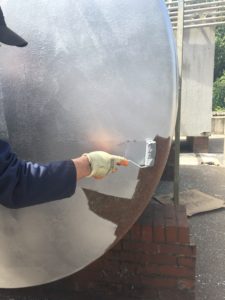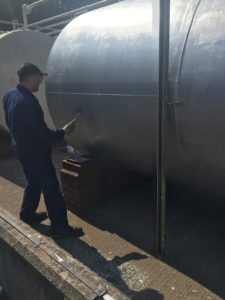Much of an engineer’s time is spent combating rust and corrosion issues that could have been prevented with some pre-emptive measures. Hindsight is both a blessing and a curse. Peter Crossen explains why
Many businesses operate under the impression that rust is an unavoidable consequence of production.
Whether it’s flash rusting on manufacturing infrastructure or pipes corroding in chemical manufacturing plants, there’s often an attitude of acceptance to the onset of rust. It’s not until rust has begun to seriously impede production that action is taken.
This reactive approach is a risky one, as leaving treatment until it is too late can lead to equipment and infrastructure passing the point of no return and requiring replacement.
 As a result, the global cost of rust management and repairs across industries reaches a terrifying total of US $2.2 trillion, according to George F Hayes of the World Corrosion Organisation. Yet a large percentage of this could be saved by pre-empting corrosion and effectively protecting assets.
As a result, the global cost of rust management and repairs across industries reaches a terrifying total of US $2.2 trillion, according to George F Hayes of the World Corrosion Organisation. Yet a large percentage of this could be saved by pre-empting corrosion and effectively protecting assets.
Always there
It is understandable that much of the rust in factories goes undetected until it’s too late.
Thorough inspections can be difficult to complete regularly, and even the most experienced engineers may find themselves missing problem areas. Unless it’s a case of flash rusting, it’s even possible for internal engineers to fail to notice some rust build up at all; becoming blind to it as it creeps in.
As humans we can get too familiarised with our surroundings, which leads to an interesting psychological concept known as ‘creeping normality’. This term describes the unconscious acceptance of a change so long as it occurs gradually enough.
So when rust and corrosion begin to slowly creep along the piping in a chemical manufacturing plant, or form corrosive deposits on construction chains, it often gets overlooked until the pipe clogs up or the chain links crumble.
This is why NCH Europe conducts on-site surveys to identify potential hazards and rust build ups that were developing undetected. Surveying also allows us to offer a bespoke application solution based on individual needs.
 While we could simply offer a rust removal solution and walk away, there’s more that can be done to provide sustainable protection from corrosion.
While we could simply offer a rust removal solution and walk away, there’s more that can be done to provide sustainable protection from corrosion.
Removing rust from equipment and surfaces may solve the immediate problem, but it can become a costly cycle that doesn’t offer a long-term solution. Engineers would be locked into an endless retrospective battle with rust.
Instead, we advise maintenance engineers to invest in an integrated approach to asset treatment that prevents corrosion from creeping onto surfaces. By making sure that rust never has an opportunity to build up, the war is won.
To achieve this NCH Europe has developed a comprehensive treatment programme that delivers a three-pronged attack to rust. By using products that address pre-treatment, encapsulation or rust removal and coating, engineers can maintain a corrosion-free plant on a long-term basis.
Three step solution
Using the right products correctly and adhering to a strict regime makes rust management a simple and straightforward process.
Once loose surface rust has been removed, using an industrial degreaser can ensure that no contaminants are left behind that will render further treatment futile. This pre-treatment step is arguably the most important.
Rather confusingly, rust removal solutions form the second step. Although the loose rust has been banished, the effects of underlying corrosion will still be present and could pose a risk to the integrity of the infrastructure. By using an effective rust treatment product this corrosion can be prevented.
However, to keep rust from returning it is essential that the surface is maintained with a product that can prevent moisture penetration causing corrosion on the substrate.
Otherwise, maintenance engineers will find themselves locked in the same struggle time and time again. By painting on either a temporary or permanent protective coating after removing rust, or regularly assessing this protective coating, even the most susceptible surface can avoid corrosion.
Keeping up with the three-step programme can be demanding. This is why it’s beneficial to find prevention products that can not only endure harsh conditions but can also last for as long as possible.
To this end, we have developed Salvage 2+ to last longer and simplify the process for permanent structures. Due to its durable composition of resin-based epoxy mixed with micro aluminium and glass flakes, the product combines the encapsulation and protection stages. It can be applied directly onto rusty surfaces to encapsulate and stop rust in its tracks.
Salvage 2+ has also been subjected to extensive scribed hot spray testing, achieving 3000 hours before corrosion sets in. This is six times as long as some protective coating products already on the market, demonstrating the endurance of the product under harsh conditions which accelerate the onset of rust.
Hindsight may be both a blessing and a curse, but if you take the steps to enforce a regime of rust prevention looking back will only be a positive experience.
Peter Crossen is VP of water, energy and maintenance solutions provider NCH Europe’s Maintenance and Partsmaster Innovation Platform.
 Engineer News Network The ultimate online news and information resource for today’s engineer
Engineer News Network The ultimate online news and information resource for today’s engineer





